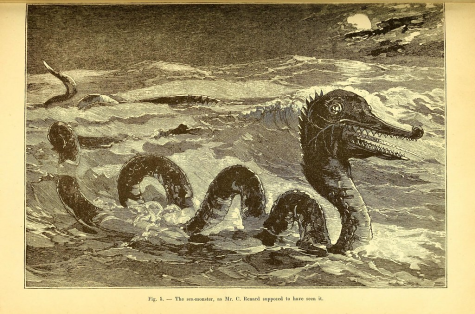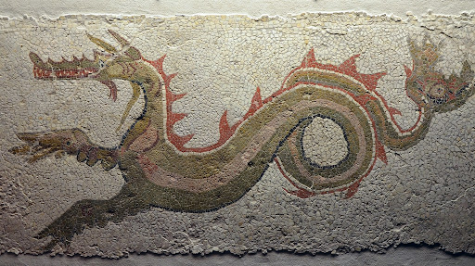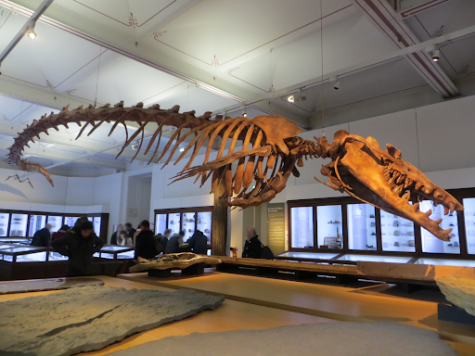Mysteries, Oddities, and Everything Strange: Leviathan
April 4, 2022
Leviathan: A Sea Monster of Legend
The ocean is a terrifying place. 80% of the water on Earth has never even been touched by humanity, and no one knows what could possibly be living in there. The legends people have created throughout the ages to represent the undiscovered mysteries are plentiful and downright horrible. From the terrifying tentacles of the Kraken to the mysterious songs of sirens (that are actually manatees). Although each and every one of these strange monsters has a reputation of its own, none quite compares to the countless far-fetched tales that  have circulated around about the greatest sea monster of all time: the Leviathan. But how did the Leviathan come to be? And is it really a fearful sea monster, or is it nothing but a misinterpreted piece of floating driftwood at sea?
have circulated around about the greatest sea monster of all time: the Leviathan. But how did the Leviathan come to be? And is it really a fearful sea monster, or is it nothing but a misinterpreted piece of floating driftwood at sea?
Similar to many other sea legends, like Nessie and Champ, the Leviathan is a sea serpent. It is known to inhabit oceans across the world without a certain abode. The first descriptions of the Leviathan are sourced from the Hebrew Bible, being mentioned in multiple sections (including the Book of Isaiah and Psalms). The Leviathan is associated with chaos and evil, being associated with envy in the legend of the seven deadly sins. The word Leviathan is derived from the Hebrew Livyatan, and the root of that word most directly means “to twist.”
Sea serpents have been documented in religious legends for centuries. Ancient Sumerian texts and illustrations reveal the existence of a serpent with seven heads being overpowered by the god of hunting and healing known as Ninurta. Babylonian legend describes a cataclysmic event of the battle between serpent goddess Tiamat and patron god Marduk. Marduk emerged victorious, and he used the body of Tiamat to create the division between Earth and the heavens.
In the Hebrew Bible, the Leviathan is mentioned and described in multiple places. In Job 41:1-34, the Leviathan is noted to have the ability to breathe fire, indestructible scales, and overall an unimaginable power source that left it as a legendary impermeable creature. Other spots in the Hebrew Bible describe the Leviathan not as a monster but as any other fish or dolphin living in the sea as an honorable creature. The Leviathan has been a significant part of countless religions, but its largest spotlight is found in that of Judaism.
Leviathan is noted to have the ability to breathe fire, indestructible scales, and overall an unimaginable power source that left it as a legendary impermeable creature. Other spots in the Hebrew Bible describe the Leviathan not as a monster but as any other fish or dolphin living in the sea as an honorable creature. The Leviathan has been a significant part of countless religions, but its largest spotlight is found in that of Judaism.
So the Leviathan is a deadly sea lizard from religious legend that rivaled the powers of God. But does it really have any viability in the real world? Are thousand-year-old tales making a resurgence in the real world? If you were to look to the Wadi Al-Hitan region in southwest Egypt, this question might become a bit more complicated than first meets the eye. This fossil dig site has unveiled many secrets of ancient life buried under the sand, but one significant find has been marked as possible Leviathan remains. It is mostly known to house whales that died thousands of years ago, but one has trumped the other discoveries for its sheer size. Basilosaurus, also known as “King Lizard,” reaches a length of over 70 feet with a 1.5 meter long skull. Its bite force of 3,600 pounds per square inch would be able to break a human skull 7 times over and is similar in power to the saltwater crocodile. When reading various verses found in the Hebrew Bible, the similarities between the Leviathan and “King Lizard” are undeniable.
 The possibility of the Leviathan being a squid, octopus, crocodile, or any other intimidating sea creature have been wholly eliminated. Some have proposed a plesiosaur as a legitimate competitor for the identity of the Leviathan, but its lack of a powerful neck eliminates it from the race. Some have suggested that the term was an umbrella for any fearsome water beast possible in order to accommodate the large amounts of whale species still prowling the waters, but the descriptions of the Leviathan would not suffice. The Leviathan was a frivolous creature, one that would defy any scientific explanations.
The possibility of the Leviathan being a squid, octopus, crocodile, or any other intimidating sea creature have been wholly eliminated. Some have proposed a plesiosaur as a legitimate competitor for the identity of the Leviathan, but its lack of a powerful neck eliminates it from the race. Some have suggested that the term was an umbrella for any fearsome water beast possible in order to accommodate the large amounts of whale species still prowling the waters, but the descriptions of the Leviathan would not suffice. The Leviathan was a frivolous creature, one that would defy any scientific explanations.
Remains of the basilosaurus have been found all across the Middle East, from Egypt to Jordan to reaching as far east as Pakistan. Many have brought up how the whale went extinct 34 million years ago, but many animals have defied all expectations. The coelacanth was sworn to have gone extinct multiple million years ago until it was discovered alive almost 90 years ago. Sightings of massive sea serpents have persisted from the Middle Ages to today, and unexplained phenomena still occur everyday on the shores of massive oceans. Who’s to say that the Leviathan could still be lurking in the unexplored depths of almost 71% of Earth’s surface covered by water. Anything is possible, right? So, next time you take a visit to the shores of the nearest beach, keep an eye out in the distance for a sea monster of unimaginable proportions—or maybe just a really big whale.
Resources:
https://en.wikipedia.org/wiki/Leviathan
https://www.britannica.com/topic/Leviathan-Middle-Eastern-mythology
https://christiananswers.net/dinosaurs/j-site4.html
https://watchjerusalem.co.il/1064-are-these-the-bones-of-leviathan






















































